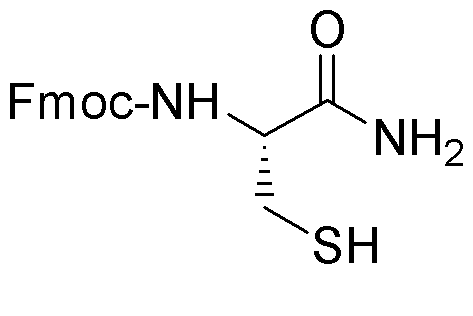Fmoc-L-cysteine amide is widely utilized in research focused on:
- Peptide Synthesis: This compound serves as a critical building block in the synthesis of peptides, particularly in solid-phase peptide synthesis (SPPS), allowing for the incorporation of cysteine residues, which are essential for forming disulfide bonds in proteins.
- Drug Development: Its application in medicinal chemistry aids in the design of cysteine-containing compounds that can act as potential therapeutics, particularly in targeting diseases where cysteine plays a role in the biological mechanism.
- Bioconjugation: Fmoc-L-cysteine amide is used in bioconjugation processes, facilitating the attachment of biomolecules to surfaces or other molecules, which is crucial for developing biosensors and targeted drug delivery systems.
- Research on Protein Folding: The compound is valuable in studies related to protein folding and stability, helping researchers understand how cysteine residues influence protein structure and function.
- Antioxidant Research: Its properties allow for exploration in antioxidant studies, where cysteine's thiol group can be investigated for its ability to scavenge free radicals, contributing to the development of new antioxidant therapies.
General Information
Properties
Safety and Regulations
Applications
Fmoc-L-cysteine amide is widely utilized in research focused on:
- Peptide Synthesis: This compound serves as a critical building block in the synthesis of peptides, particularly in solid-phase peptide synthesis (SPPS), allowing for the incorporation of cysteine residues, which are essential for forming disulfide bonds in proteins.
- Drug Development: Its application in medicinal chemistry aids in the design of cysteine-containing compounds that can act as potential therapeutics, particularly in targeting diseases where cysteine plays a role in the biological mechanism.
- Bioconjugation: Fmoc-L-cysteine amide is used in bioconjugation processes, facilitating the attachment of biomolecules to surfaces or other molecules, which is crucial for developing biosensors and targeted drug delivery systems.
- Research on Protein Folding: The compound is valuable in studies related to protein folding and stability, helping researchers understand how cysteine residues influence protein structure and function.
- Antioxidant Research: Its properties allow for exploration in antioxidant studies, where cysteine's thiol group can be investigated for its ability to scavenge free radicals, contributing to the development of new antioxidant therapies.
Documents
Safety Data Sheets (SDS)
The SDS provides comprehensive safety information on handling, storage, and disposal of the product.
Product Specification (PS)
The PS provides a comprehensive breakdown of the product’s properties, including chemical composition, physical state, purity, and storage requirements. It also details acceptable quality ranges and the product's intended applications.
Certificates of Analysis (COA)
Search for Certificates of Analysis (COA) by entering the products Lot Number. Lot and Batch Numbers can be found on a product’s label following the words ‘Lot’ or ‘Batch’.
*Catalog Number
*Lot Number
Certificates Of Origin (COO)
This COO confirms the country where the product was manufactured, and also details the materials and components used in it and whether it is derived from natural, synthetic, or other specific sources. This certificate may be required for customs, trade, and regulatory compliance.
*Catalog Number
*Lot Number
Safety Data Sheets (SDS)
The SDS provides comprehensive safety information on handling, storage, and disposal of the product.
DownloadProduct Specification (PS)
The PS provides a comprehensive breakdown of the product’s properties, including chemical composition, physical state, purity, and storage requirements. It also details acceptable quality ranges and the product's intended applications.
DownloadCertificates of Analysis (COA)
Search for Certificates of Analysis (COA) by entering the products Lot Number. Lot and Batch Numbers can be found on a product’s label following the words ‘Lot’ or ‘Batch’.
*Catalog Number
*Lot Number
Certificates Of Origin (COO)
This COO confirms the country where the product was manufactured, and also details the materials and components used in it and whether it is derived from natural, synthetic, or other specific sources. This certificate may be required for customs, trade, and regulatory compliance.


